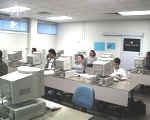| Computer-Based Learning |
|
CBL stands for Computer
-Based Learning- sometimes known as
e-Learning. CBL courses may use ...
- text - notes and other resources
- graphics
- sound - a commentary or music
background
- animation
- self assessments
- for the student to know how much has been learned.
- file transfer - for
uploading students' work, or downloading assessed work
CBL systems use interactive
computing.
A VLE (Virtual Learning
Environment) works over the Internet to provide tools for a student to
learn. |
You are using
CBL right now! |
|
Benefits of CBL...
- more interesting learning with
interactive systems and multimedia - so greater motivation
- students can learn at any time
- students can learn from any place eg home
- students proceed at their own pace
Help or advice can usually be obtained through an on-line
messaging service,
email,
bulletin boards or blogs.
Another advantage of CBL - anyone can do it. Learning for Life -
|
 |
|

|
Pupils
generally learn better when they study on their own and can learn at
their own pace. |
|
CBT = Computer
Based Training - Using the computer as an instructor. CBT may
include tutorials, practice exercises
and feedback on the student's
learning progress.
|
|
|
Virtual
Reality
systems are being developed where the user puts on a helmet which
projects images into the eyes using small computer screens, and a virtual
reality glove which inputs the users hand movements.
Although great for computer games, there are serious uses as
well. VR systems are being developed to help student surgeons; a
CAT (Computer Aided Tomography) scan can create a 3-dimensional
picture of the human body. A surgeon can put on a VR helmet and
feel as if he is walking around inside the patient! He can view
eg a tumour from different angles etc..
|
|
|
|
|
|
|
| |
 |
| |